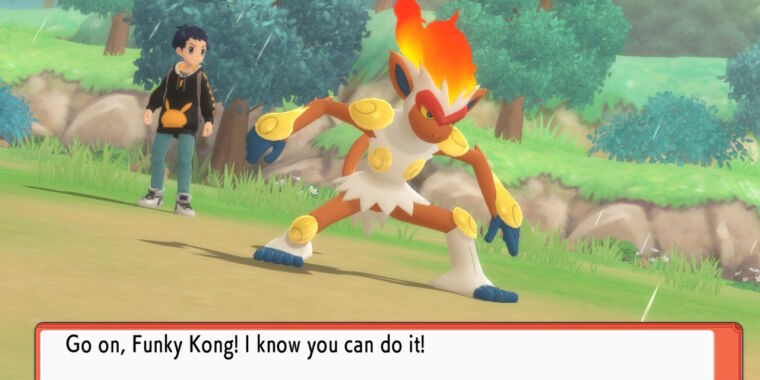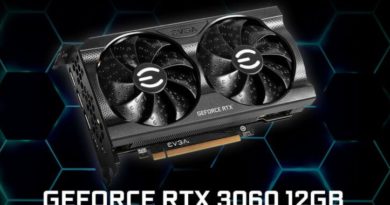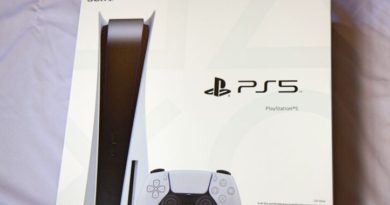Pokémon Brilliant Diamond and Shining Pearl review: Un-bucking convention
[ad_1]

Nintendo
Pokémon Sword and Pokémon Shield may have disappointed some of the series’ most devoted fans with their truncated Pokédexes, but that doesn’t seem to have hurt them much with the game-buying public. The two titles are, collectively, the fifth best-selling game in the Switch’s history, trailing only Mario Kart 8 Deluxe, the Switch iterations of Smash Bros. and Animal Crossing, and The Legend of Zelda: Breath of the Wild. They’re the best-selling Pokémon games since Pokémon Gold and Silver were released at the height of late-’90s/early-’00s Pokémania over two decades ago.
Part of Sword‘s and Shield‘s appeal, as we explored a bit in our review, was that they used the Switch’s extra hardware power to create a truly console-sized adventure, crafting a world with an impressive sense of scale and the series’ first free-roaming overworld areas. There were still some weird quirks—story cutscenes with mouth movements but no actual spoken dialogue come to mind—but it felt like the series had finally broken free of some of the conventions it had been leaning on since the earliest Game Boy entries.
In that context, Pokémon Brilliant Diamond and Pokémon Shining Pearl can’t help but feel like a bit of a letdown. The games are faithful to their source material, but that source material is a pair of games released on the original Nintendo DS in 2007, and both the originals and the remakes hew much more closely to the series’ Game Boy roots. It’s not that there aren’t improvements—it’s just that, even relative to other Pokémon remakes, Brilliant Diamond and Shining Pearl feel inessential.
They’re Pokémon games
-
Diamond and Pearl still used a top-down perspective and 2D chibi-style sprites. The style is preserved in the remake, albeit in full 3D.
Nintendo -
After swiping a Pokémon from a professor’s suitcase, you embark on an adventure through the Sinnoh region.
Nintendo -
Typical battles play out much as they do in Sword and Shield, in full 3D arenas.
Nintendo -
Your Pokémon’s status screens are stuffed with info about the creatures’ stats and other abilities.
Nintendo -
You’ll become the Sinnoh region’s Pokémon League Champion because you understand concepts like “actually carrying a full team of six Pokémon.”
Nintendo
The shortest, truest review I could write of Pokémon Brilliant Diamond and Shining Pearl is that they are Pokémon games. If you like Pokémon games, you will probably enjoy them. If you don’t care for Pokémon games, these won’t change your mind.
As in most of the series’ other entries, you begin the game as a Pokémon-less youth who has waited until now to obtain your first Pokémon even though everyone you talk to is constantly jabbering about Pokémon. After receiving a pre-captured monster from a local eccentric academic, you quickly master elementary concepts that no one else in the world seems to understand, like “carrying six Pokémon with you at all times” and “using more than one Pokémon type.” You explore the Sinnoh region, catching new Pokémon and acquiring badges from Gym Leaders, until eventually you use your monster battling skills to attain cultural and strategic hegemony at the top of Sinnoh’s Pokémon League.
-
The chibi character designs aren’t always served well by close-up shots, but the characters’ huge eyes and giant heads are mostly endearing.
Nintendo -
Exaggerated chibi-style character models in the overworld…
Nintendo -
…give way to human-proportioned character designs in battles.
Nintendo -
The DS games used the console’s bottom screen for something called the “Pokétch,” short for Pokémon Watch, short for Pocket Monsters Watch. It’s preserved in the remakes, but as a pop-up that you summon and dismiss with the R button.
Nintendo -
Most of the Pokétch apps were handy enough to have on a second screen that otherwise wouldn’t have been doing anything, but in the remakes they’re rarely useful enough to justify the screen space on the Switch.
Nintendo
Catching, raising, and battling Pokémon has always been the bedrock of the series, and the rock-paper-scissors-style battle system remains satisfyingly easy to learn but difficult to master. And as much as I miss Sword‘s and Shield‘s more ambitious graphics and design, developer ILCA has done a clever job of melding the cute chibi art style used in the overworld with the more realistically rendered Sword and Shield-like characters and 3D arenas used for battles. And for younger players who enjoyed the Pokémon Let’s Go games, the simpler and more linear structure of Brilliant Diamond and Shining Pearl will be easier to follow and understand than Sword and Shield.
But for series veterans, there are parts of Brilliant Diamond and Shining Pearl that feel threadbare, especially for a $60 console game. The level grinding, rigidly linear exploration, barely there story, bland dialogue, and simple city and town designs are all way too familiar at this point. And the locations you visit and the characters you meet (including this iteration’s Team Rocket-esque gang of petty criminals, Team Galactic) are among the series’ least-memorable. There’s rarely a reason to revisit locations on Sinnoh’s map after you’ve been there once (other than to pick berries you’ve planted), and you need to get pretty deep into the main story before you’ll be challenged by most of the trainers or Gym Leaders you fight.
-
The Grand Underground is one of the remakes’ better additions. It can be navigated solo, via local Wi-Fi play, or on the Internet (we weren’t able to test out either of the multiplayer modes).
Nintendo -
It adapts the sprawling underground tunnels from the original game…
Nintendo -
…but with large biome-based rooms where a wide variety of Pokémon can be seen and chased (the rest of the game still uses long-grass-random battles).
Nintendo -
A mining mini game provides gems that can be traded for other items, decorations for your Secret Base, and evolution stones and other items.
Nintendo
One bright spot—and one of the remakes’ larger additions to the original game—is the Grand Underground, a subterranean network of tunnels that runs beneath the entire Sinnoh region. The original games had a similar Underground area, where you could dig up and trade rare items and create and decorate “secret bases” to show your friends while playing over Wi-Fi. The remakes expand the network of tunnels with themed rooms designed around different biomes. Each of these rooms is filled with biome-appropriate Pokémon, and these Pokémon are visible on the map rather than being random encounters.
This is as close as the Diamond and Pearl remakes get to Sword and Shield‘s Wild Area, and, in the early- to mid-game, the Grand Underground serves as a convenient way to catch a wider variety of Pokémon to fill out your team roster. Exploring each of these rooms and playing the item-finding mining minigame are both entertaining ways to break up the main adventure when it gets to be too monotonous.
[ad_2]
Source link




